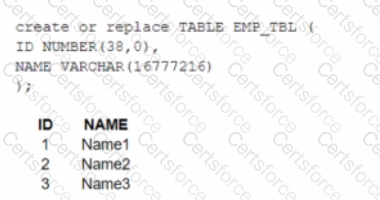An Architect has a VPN_ACCESS_LOGS table in the SECURITY_LOGS schema containing timestamps of the connection and disconnection, username of the user, and summary statistics.
What should the Architect do to enable the Snowflake search optimization service on this table?
Consider the following COPY command which is loading data with CSV format into a Snowflake table from an internal stage through a data transformation query.

This command results in the following error:
SQL compilation error: invalid parameter 'validation_mode'
Assuming the syntax is correct, what is the cause of this error?
A company is using a Snowflake account in Azure. The account has SAML SSO set up using ADFS as a SCIM identity provider. To validate Private Link connectivity, an Architect performed the following steps:
* Confirmed Private Link URLs are working by logging in with a username/password account
* Verified DNS resolution by running nslookups against Private Link URLs
* Validated connectivity using SnowCD
* Disabled public access using a network policy set to use the company’s IP address range
However, the following error message is received when using SSO to log into the company account:
IP XX.XXX.XX.XX is not allowed to access snowflake. Contact your local security administrator.
What steps should the Architect take to resolve this error and ensure that the account is accessed using only Private Link? (Choose two.)
A table, EMP_ TBL has three records as shown:

The following variables are set for the session:

Which SELECT statements will retrieve all three records? (Select TWO).
How can an Architect enable optimal clustering to enhance performance for different access paths on a given table?
At which object type level can the APPLY MASKING POLICY, APPLY ROW ACCESS POLICY and APPLY SESSION POLICY privileges be granted?
An Architect for a multi-national transportation company has a system that is used to check the weather conditions along vehicle routes. The data is provided to drivers.
The weather information is delivered regularly by a third-party company and this information is generated as JSON structure. Then the data is loaded into Snowflake in a column with a VARIANT data type. This
table is directly queried to deliver the statistics to the drivers with minimum time lapse.
A single entry includes (but is not limited to):
- Weather condition; cloudy, sunny, rainy, etc.
- Degree
- Longitude and latitude
- Timeframe
- Location address
- Wind
The table holds more than 10 years' worth of data in order to deliver the statistics from different years and locations. The amount of data on the table increases every day.
The drivers report that they are not receiving the weather statistics for their locations in time.
What can the Architect do to deliver the statistics to the drivers faster?
A new user user_01 is created within Snowflake. The following two commands are executed:
Command 1-> show grants to user user_01;
Command 2 ~> show grants on user user 01;
What inferences can be made about these commands?
An Architect needs to grant a group of ORDER_ADMIN users the ability to clean old data in an ORDERS table (deleting all records older than 5 years), without granting any privileges on the table. The group’s manager (ORDER_MANAGER) has full DELETE privileges on the table.
How can the ORDER_ADMIN role be enabled to perform this data cleanup, without needing the DELETE privilege held by the ORDER_MANAGER role?
Which of the below commands will use warehouse credits?